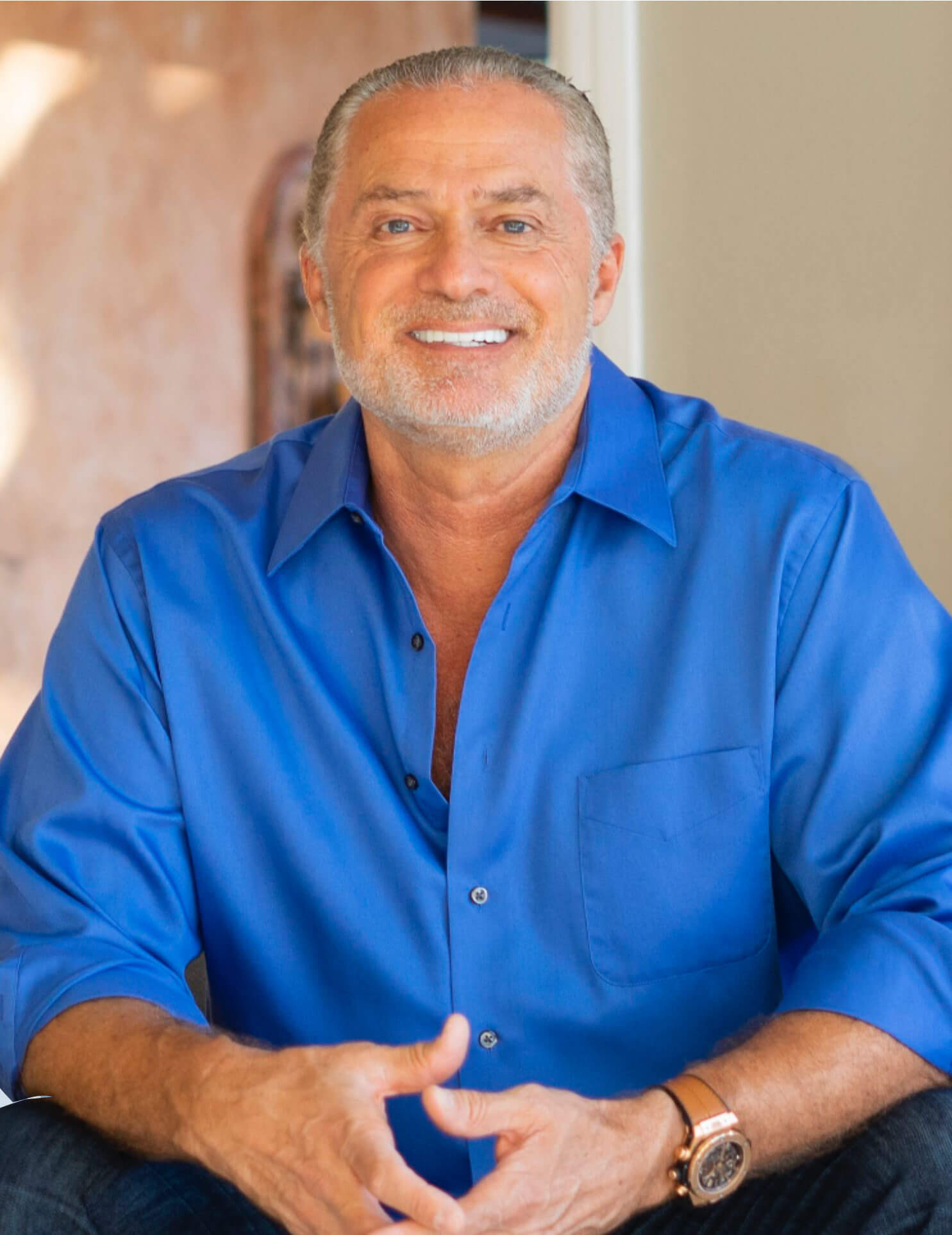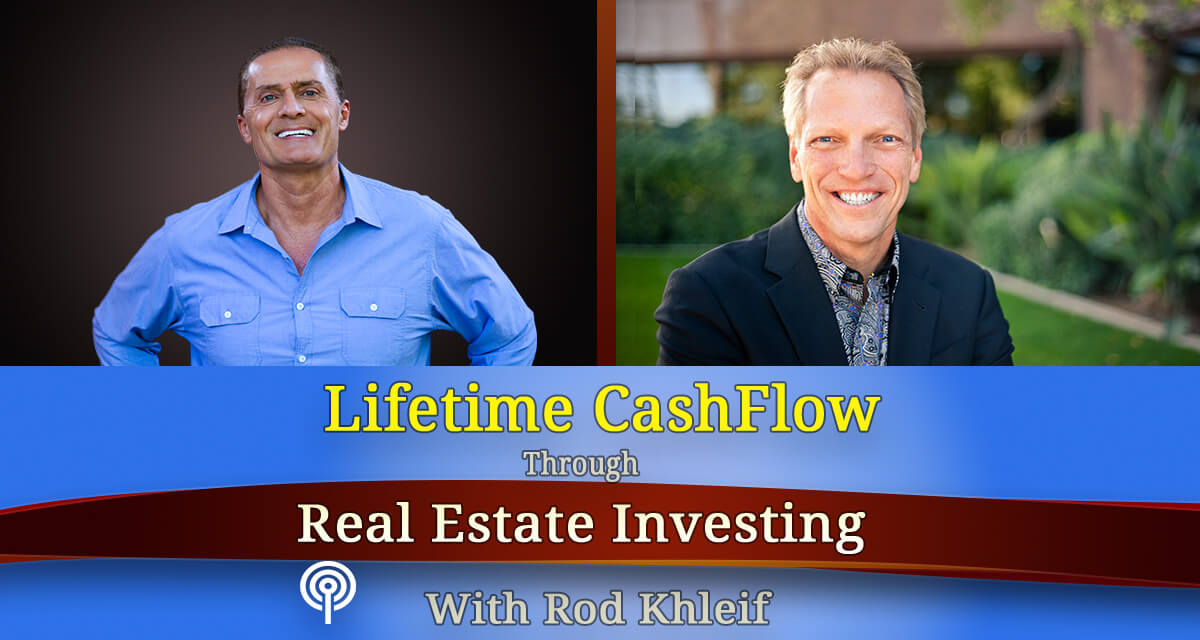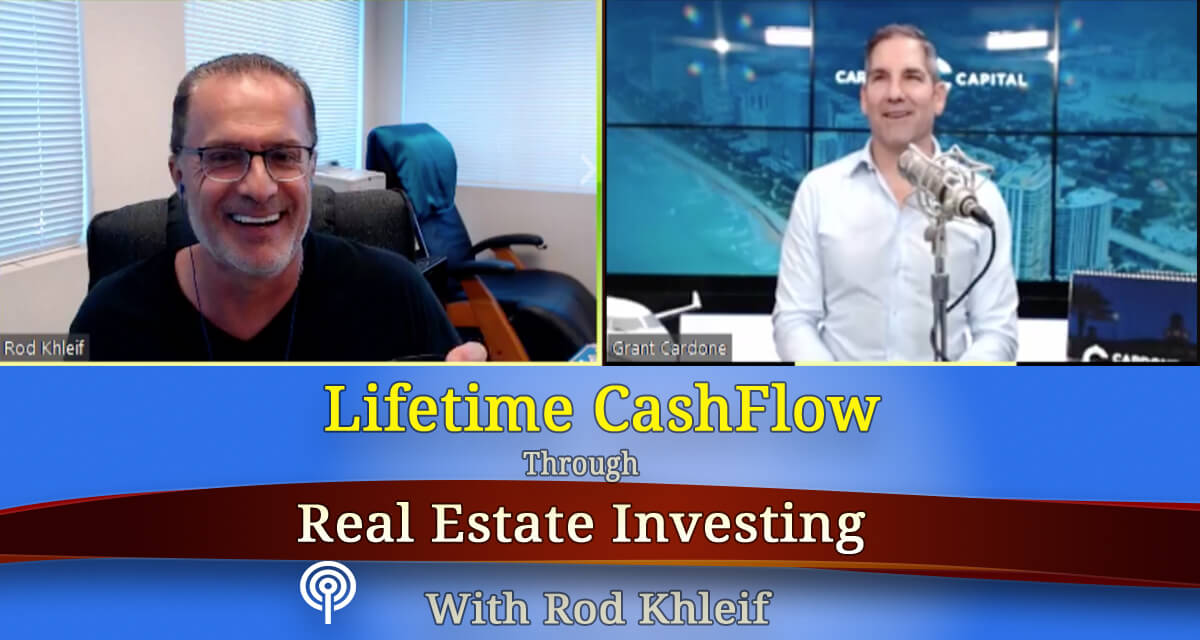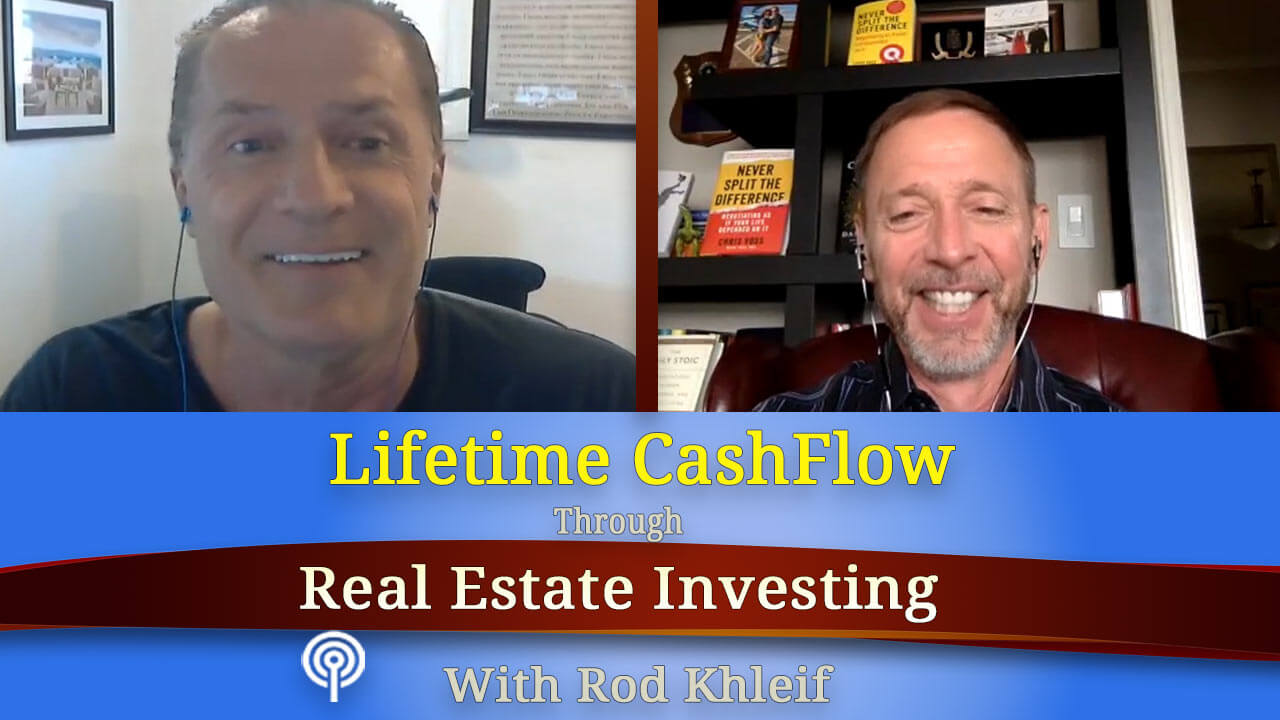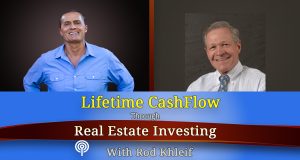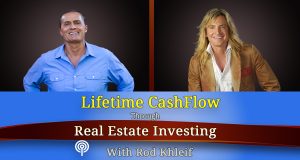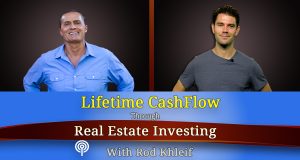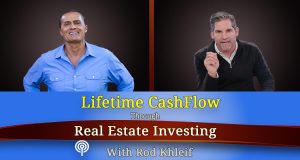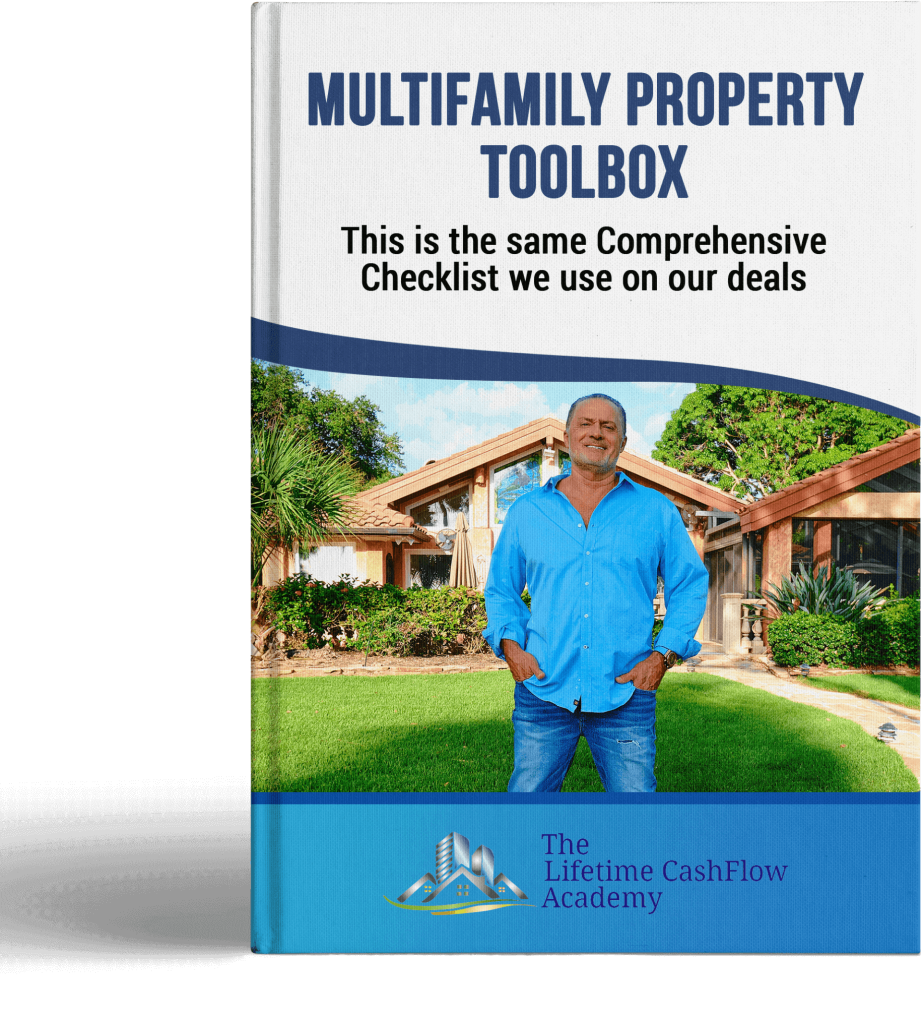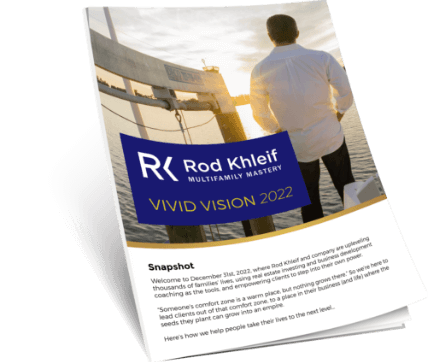In this powerful episode of Lifetime Cash Flow through Real Estate Investing, Rod Khleif and Mark Nagy break down the current multifamily real estate market with clarity and insight you won’t want to miss. Here’s the real deal, straight from the trenches:
Multifamily Market Meltdown & Massive Opportunity:
- Multifamily operators are facing serious challenges due to adjustable-rate bridge debt and declining rents in key markets like Texas, Georgia, and the Carolinas. Occupancy rates have dropped to around 60-65%, far below the 85% needed to break even.
- Sales volume has plummeted by about 90%, and foreclosures are increasing as banks try to avoid balance sheet hits by deferring payments.
- Despite this turmoil, Rod sees extraordinary opportunities ahead for savvy investors with cash ready to deploy. The market is ripe for those who are prepared.
Single Family Housing Shortage & Market Dynamics:
- The U.S. faces a massive housing shortage, worsened by immigration and a lack of new construction. Prices have remained stable or even increased about 9% year-over-year.
- The disparity between rent and mortgage payments is pushing more people into renting, making multifamily and single-family rentals a critical part of the housing solution.
- New home construction is rising, especially on federal land and suburban outskirts, which could ease pricing pressures over time.
Market Shifts & Geographic Trends:
- Hot markets during the COVID boom like Florida, Texas, and Arizona are cooling off, while Midwest cities such as Kansas City, Milwaukee, and Columbus are seeing rent growth and stability.
- Rod remains bullish on the South and Texas long-term, despite short-term pullbacks and insurance challenges from recent natural disasters.
Interest Rates & Economic Outlook:
- Interest rates remain elevated, with forecasts from Fannie Mae, Freddie Mac, and others predicting 30-year mortgage rates around 6.1-6.3% through 2024, dropping to about 5.7-5.8% in 2025.
- Rod reminds us that historically, you can make money at any interest rate as long as prices adjust accordingly. He recalls when 7% rates felt like a blessing compared to the 18% rates in the late 1970s.
Political Impact on Real Estate:
- Potential policy changes, like a $25,000 first-time homebuyer credit or removing tax benefits for investors owning more than 50 single-family homes, could disrupt the market and discourage investment, ultimately hurting housing affordability.
- Rod stresses the importance of minimizing government interference and red tape, especially around building regulations, to keep housing supply growing.
Rod’s Advice for Investors:
- Don’t wait for the “perfect” time to buy. Use this time to educate yourself, build relationships, and get ready. When deals hit, you want to be prepared to act fast.
- Rod’s upcoming boot camp is designed to equip you with everything you need to succeed—from market evaluation to financing and syndication. Use code “podcast” at MultifamilyBootCamp.com for a special rate.
- For accelerated growth, Rod’s Warrior Mentorship program offers one-on-one coaching and access to a powerful network of investors owning over 210,000 units nationwide.
This episode is packed with actionable insights and a no-nonsense look at the multifamily market’s current state and future. If you want to thrive in this environment, now is the time to get educated, get connected, and get ready to crush it.
Remember, in real estate, crisis equals opportunity. Let’s get after it.
In Today’s Episode You’ll Learn
Topics Covered:
- The Bridge Debt Multifamily Meltdown
- Massive Opportunities in Multifamily
- Sky-High Real Estate Interest Rates
- These Markets Are Thriving Despite the Economic Chaos
- Similarities Between Today & The Dot Com Bubble Bursting
- How Money Printing Fueled Record-Breaking Inflation
- The Ultimate Hack to Building Powerhouse Connections in Multifamily
- Educate Yourself NOW to Seize Game-Changing Deals
If you’d like to apply to the warrior program and do deals with other rockstars in this business: Text crush to 72345 and we’ll be speaking soon.
For more about Rod and his real estate investing journey go to www.rodkhleif.com
Full Transcript Below
Full Podcast Transcript: Ep #1022 – Mark Nagy on the Current Challenges and Opportunities in the Multifamily Real Estate Market
Transcript
Rod Khleif: Welcome to another edition of Life Time Cash Flow through Real Estate Investing. I’m Rod Khleif and I am thrilled you are here and you are going to love today’s guest. You know why? Because it’s me. So I’ve got I’ve got my co-host, Mark Nagy on. What’s going on? Mark?
Mark Nagy: What’s going on? Rod I’m, I’m glad we’re digging into this stuff because there’s a lot of a lot of big changes that are happening in the real estate market right now. And, glad we’re able to touch on it and just do some big value add, I think here today.
Rod Khleif: Yeah, well, we’ll do the best we can with that. I think that, you know, that’s why I’m being interviewed today, guys, because I wanted to drill down on quite a few things. Mark’s got a list of questions to ask me that we can go into as to what’s really happening, because really, there’s a meltdown happening in the multifamily space.
Rod Khleif: And, and, and of course, with crisis comes opportunity, this incredible opportunity. So, you know, Mark’s going to ask me questions. We’re going to get into it. I think you’re going to get a ton of value from today’s episode, and, let’s do it, brother.
Mark Nagy: Yeah, I think we’ll start a little broader here. Right? Because there’s there’s the rate cuts, there’s the election coming up, all those sorts of things, but just kind of start general in terms of what you’re seeing. How are you feeling about the multifamily market, the single family market? What are you seeing out there in terms of where things are going over maybe the next 12 months and just really where they’re at now?
Rod Khleif: Sure. Well, there’s a lot of questions you just asked. So let’s start with multifamily. Okay. So in the multifamily space, there are a ton of operators in trouble right now. They got adjustable rate bridge debt. Rents have pulled back in many markets and markets that I’m in, even, you know, Texas, Georgia, the Carolinas occupancy has dropped.
Rod Khleif: So, you know, there’s a lot of stress in our business right now. And so, you know, operators that haven’t been through this are really struggling and trying to come up with solutions. And, I’ve, I’ve never seen so many multifamily properties on the market as I’m seeing right now. I literally get dozens of emails a day of new properties hitting the market.
Rod Khleif: Sales are down about 90%. And so, you know, again, there are incredible opportunities coming in. So I’m excited. I mean, we’re we’re we’re in a lot of cash. We’re, we’re I got access to a lot of cash. And I think the deals are just going to be extraordinary here over the next 12 months. And and a lot of people are playing, you know, on the sidelines.
Rod Khleif: A lot of the bigger players are on the sidelines. So in the multifamily space I see a tremendous amount of opportunity. There’s going to be some upset. You know, there’s already been some foreclosures. There’ll be more foreclosures, you know, banks taking assets back. But you know, this, as it relates to the 2008, 2009 crisis, this is different in that it’s specific to multifamily for the most part of this.
Rod Khleif: We’re going to see massive pain as well. I mean, occupancy across the country is at about, I don’t know, 60, 65%. Those assets don’t break even unless they’re at 85%. Now. Right now, banks are kicking these loans down the curb because if they foreclose, that immediately hits their balance sheet. So they’re doing everything they can to avoid that.
Rod Khleif: So a lot of them are doing what’s called deferrals. Well if they’ve got what they consider a creditworthy borrower, they will defer the interest or a portion of the interest or the payments or a portion of the payments and put it on the back end. And, you know, I think it is just kicking the can down the curb.
Rod Khleif: So we’ll see. We’ll see. But so that’s what’s happening in the multifamily space. And other asset classes and commercial aren’t doing as bad, retail. You know, mobile home parks are okay.
Mark Nagy:
Rod Khleif: Trying to draw a blank here, off. We talked about Austria. Oh, Industrial’s doing great, you know, so there’s some other asset classes that are still doing quite well, but multifamily definitely is going to see a reckoning and there’s going to be opportunity. And so now, let’s pivot and pivot to single family for a minute on an overarching comment.
Rod Khleif: You know, there is a huge shortage of housing in this country. I mean, and, and you know, the fact that, you know, this administration had an open border policy and there’s, I don’t know, upwards that people are saying upwards of 20 million people have come into the country, that housing shortage. We were 5 million housing units short before that happened.
Rod Khleif: Okay. So there’s a huge housing shortage. How that impacts pricing, I don’t know. Right now pricing is still stable and it’s even still gone up, compared to a third, you know, I think it went up like 9%, across the United States from the third quarter of last year to the third quarter of this year. Now, when the Fed drops the rates more, I think it could really open things up.
Rod Khleif: And we’re going to see prices go up again. But you know that’s not my wheelhouse anymore. And so I don’t pay quite as much attention to it. You know, we are becoming a renter nation. There’s no question about that. The disparity between, you know, rent pricing and mortgage payments is still very wide and makes it very difficult for people to buy single family properties.
Rod Khleif: And, you know, one of the things we should talk about is some of the impact of the election on all of that. Let’s do that later.
Mark Nagy: But, yeah, on the market, because of interest rates, multifamily prices are down, you know, anywhere from 20 to 25% just depending on the market. I know you just talked about distress and things like that. So what do you think is going to continue to happen with multifamily? Do you think it’s going to go even further down next year in 2025?
Mark Nagy: Is it going to slowly start to go back up? What’s your kind of prediction here?
Rod Khleif: Well, I mean, there’s no question they’re going to continue to go down. Yeah. There’s absolutely no question. We’re going to see much deeper price cuts, you know, and we’re also seeing lender delays affecting this whole scenario, this distress when rates went up, Fannie Mae and Freddie Mac reallocated a lot of their analysts to other departments and Fannie and Freddie.
Rod Khleif: And if you guys don’t know that Fannie and Freddie is probably the largest source of debt for multifamily assets, you know, there’s also insurance companies and there’s bank loans. But Fannie and Freddie are the conforming debt solution for multifamily. And they reallocated a bunch of their analysts when the rates went up, I mean, things slowed down.
Rod Khleif: So now they don’t have enough analysts to do new business. They also don’t have enough to do servicing properly. So, you know, for example, if you’re changing management companies, it takes forever to get their approval. I’m dealing with that on an asset right now. It should have taken a week. It’s already at about 5 or 6 weeks.
Rod Khleif: So try to get a new management company approved or, you know, a lot of the draw requests are taken forever. So a lot of times, these lenders will hold money that you draw on to do repairs. And the request to get those draws out is taking forever, which is killing these operators’ ability to handle these properties, because they put the money out and don’t get it back in a reasonable amount of time. We’re seeing that on our deals as well. So, you know, that relocation of analysts, they already didn’t have enough. And with the reallocation and now pulling them back in and everything, it’s just a mess at Fannie and Freddie Mac.
Rod Khleif: And so, you know, that’s really impacting these operators as well. But you know, so anyway, that’s in the multifamily space. Now in the single family, I will tell you that I think home sales are going to remain constrained right now as long as the rates stay around 6%. Here’s the reason: 86% of the homeowners out there have rates under 6%, you know, so the rate is going to have to get closer or below that before owners are going to want to sell.
Rod Khleif: And so that’s also constraining inventory and constraining sales. And you know, I’m going to tell you that the Federal Reserve doesn’t see inflation going sub 2% on a consistent basis until 2026, which could mean, you know, higher short-term interest rates. They’ll decline, but they’ll still be higher than the rates of the past couple of years. So, you know, the only bright thing in the whole piece here is that there’s a huge growing supply of newly built homes. So the supply for new single family homes is rising – it’s about two and a half times the level of the existing family supply.
Rod Khleif: So you know that that will affect pricing as well. We’ll see, you know, but of course, prices are very geographically driven and market dependent, based on the inventory.
Mark Nagy: So we’ll talk about that here. Okay. Right. Because that’s big time what we’re seeing here in the market. These areas that had huge booms during COVID – places like Florida, Texas, Arizona, etc. – those are the places that are the coldest right now. The places that were the hottest are now the coldest. And the places that were the coldest then are now the hottest.
Mark Nagy: Right, places like the Midwest. If we’re looking at the places for this year with the highest rent growth, you’re seeing places like Kansas City, Milwaukee, Cleveland, Pittsburgh, Columbus, Ohio, Indianapolis, Cincinnati. I know you own some assets in a few of those places, and then places with the biggest rent declines – obviously, Austin, everybody knows that one; Raleigh, you mentioned the Carolinas; Jacksonville.
Mark Nagy: Some of my properties are getting rent declines right now in Texas, Phoenix, Tampa, Dallas, etc. So what are your feelings on, if you were to give advice to the listeners short term and then long term, do you see those places coming back in terms of Florida? What are your thoughts on still where to buy right now and maybe over the next 12 months? What would be your advice?
Rod Khleif: Well, I’ll tell you, the reason they pulled back is because they grew exponentially. I mean, we saw one year in Tampa, rents went up 32%. I mean, do the math on that. Okay, it’s insane. And so it was inevitable they were going to pull back some. So that was inevitable. But, you know, we’re in some economic uncertainty right now.
Rod Khleif: You know, the proverbial, you know, what’s hitting the fan. And you know, God knows what the election results are going to be and how they’re going to impact what’s happening. But, you know, every one of those markets you just said are great markets. I’ve got assets in most of them. Yes, we’ve seen rents pull back.
Rod Khleif: Yes, we’re struggling on some of them to get occupancy up and keep it up. But you know, we’ve had to cut back on our return projections. That’s business. That’s part of this business. And so, you know, those are all great markets to still invest in. Now I don’t have a crystal ball to go short term or long term, candidly.
Rod Khleif: But I will tell you I would invest in every single market you just mentioned. And, you know, yes, you’re right – that initial group of markets you mentioned, which included Cincinnati and Kansas and some other markets, are doing better right now. I will tell you when 0809 happened, that whole Midwest region was fairly stable.
Rod Khleif: We saw the biggest price increases and decreases in the coastal cities and South Florida, Vegas, California – they all had huge price increases and then they crashed. You know, when my portfolio crashed in 2008 and 2009, I was at a 30% loan-to-value in 2007. In 2009, I was upside down. That means my portfolio dropped more than 70%.
Rod Khleif: So yeah, you’re going to see these big fluctuations in these coastal and southern markets. But I will tell you I’m still very bullish on the South, very bullish on Texas where we’ve got a ton of assets, the Carolinas, parts of Georgia, and Florida for sure. Now, of course, there’s a whole insurance dynamic that’s going to impact things in a big way.
Rod Khleif: You know, I was in Europe when Helen and Milton hit. And, you know, when Ian hit, I had about $1 million worth of damage. I settled for under $1 million on my compound. This time, luckily, I didn’t have any damage to my buildings, but my boat ended up three houses away. My jet skis ended up in my backyard.
Rod Khleif: My dock is destroyed. It’s hilarious. It looks like something out of Doctor Seuss because it’s leaning in different directions as you walk down it. It’s hilarious. But, you know, yeah, insurance is going to be a real problem for any of these areas that were impacted by those storms. I mean, look at what’s happened in the Carolinas.
Rod Khleif: My God, they’re still searching for bodies. It’s horrific. I thought, candidly, that Milton was going to be a lot worse because it was coming in at one in the morning. I thought I was going to get flooded. Thank God it wasn’t as bad as I hoped. I mean, yeah, people died, but not as many as I anticipated.
Rod Khleif: So anyway, insurance is going to be an issue for any asset in those markets. We’re just going to have to muddle through, and pricing is going to have to adjust based on what’s happening with insurance. That’s what happens; the market adjusts the pricing. And that’s why the politicians need to stay the hell out of it, because the market will adjust based on what’s happening.
Rod Khleif: And you know, when politicians print money, that’s when things get screwed up. That’s why inflation – I mean, I think their base and the inflation numbers, candidly, maybe you’ve heard me talk about this on the show – literally, our debt is going up $1 trillion every hundred days. I mean, it’s insanity.
Rod Khleif: We’re paying over 1.2 trillion a year so far on that debt, about 2 billion a day, I believe. I mean, it’s insane. And so in the last four years, 80% of the currency has been created. Up until 2020, only 20% of the currency was in place. Since then, we’ve created another 80%.
Rod Khleif: I mean, hello, this is why we have inflation, and, you know, so don’t get me started on politics. In fact, we should probably talk about the election. You want to talk about that?
Mark Nagy: But well, before we do, really quickly, I’ll have to give you some data that supports exactly what you just said. Obviously, places like Texas and Florida still have the long-term fundamentals, right? Oh sure, still going up – population is still growing. So I totally agree with you. And if we look at it, I have a chart here that talks about what our returns in the real estate market were after every time the Fed started cutting rates. 2007 was actually the only one in the past 50 years where returns actually went down over the next 2 or 3 years.
Mark Nagy: So the dot-com bubble in 2000, the returns over the next 2 or 3 years after the Fed started cutting rates were massive – 1989, 1984, and 1981. I don’t know if you can speak to what those were, but apparently the Fed started easing rates then and there were massive turns after that. And there were…
Rod Khleif: Crashes. Then the S&L crisis. There were crashes then. And so, you know, that’s…
Mark Nagy: What’s so…
Rod Khleif: Right. Right.
Mark Nagy: I can’t speak to that. That’s why I asked. But there were still massive returns over the next 2 to 3 years. So it’s not something to be afraid of. But yes, let’s talk about the election. I know you mentioned… well, where do you want to start – insurance or what?
Rod Khleif: Oh, no, I mean, we talked about insurance, I think. I mean, well, let’s talk about the election next. Let’s do that. So, you know, what’s the impact of the election results going to be on the housing market, Fannie? Oh, trust me, it’s huge. Freaking huge. Okay, if Kamala Harris gets elected – I mean, guys, you can hate me for this – I don’t give a shit, okay? I think we’re doomed. She’s suggesting a $25,000 credit to go to first-time homebuyers. Okay, well, who pays for that? I mean, hello, how fair is that to the people, to the first-time homebuyers that are buying right now? I mean, come on, you know. Also, what she’s talking about is removing tax benefits for investors that own more than 50 single family homes.
Rod Khleif: And so obviously that hurts our business. She thinks that’s going to help. You know, I get a lot of hate online from people saying, “You shouldn’t have owned 800 houses. You’re driving up prices.” That’s BS. And I’m going to tell you that any time politicians screw with the tax benefits and the real estate game, that’s when we have serious problems – as evidenced by the S&L crisis.
Rod Khleif: That’s an example of that. The politicians got involved and it created this crash in savings and loans that were loaning a ton of money on commercial real estate. You know, she’s done a pledge to build 3 million new houses over four years. Well, that’s great – fine, that’s good – a tax incentive for homebuilders to build more starter homes and rental properties. I agree with that one. Okay, but the $25,000 thing to me is insane, okay?
Mark Nagy: Oh no. Yeah. No. You know, money to people. Yeah.
Rod Khleif: Somebody’s got to pay for that stuff. I mean, that’s just like the whole student loan thing – where they were going to pay off all the student loans. Well, you know who’s paying for that? And what about the people that actually had to pay, like my daughter for her student loans? That’s not fair. So when you remove these key tax benefits for major investors, it discourages investment, and that’s the death knell of any Democratic society – when investment is discouraged, it hurts affordability as well.
Rod Khleif: And I’m going to tell you, there are build-to-rent investors out there that are providing family-sized housing that if they get discouraged by such policies, whether she likes it or not, we need investors to invest in single family rentals.
Rod Khleif: More capital invested in single family rentals means lower rents for families. So removing those tax benefits is going to increase rents, you know. And so, you know, I disagree with most of what she’s trying to do. And, if you listen to me, I’m definitely on the other side anyway. But, you know, Donald Trump’s housing policies – he’s going to reduce illegal immigration and ban mortgages for immigrants that don’t have legal status.
Rod Khleif: I mean, hello, does that make sense to me? Okay, people that don’t have legal status here – he’s going to open up federal land for home construction. I think that’s brilliant because there are millions of acres of federal land that could help with that. And he’s the big one; he’s going to eliminate a lot of the costly regulations to make homes less expensive to build, because, I mean, a lot of these municipalities make it damn near impossible to get something built here in Sarasota.
Rod Khleif: Don’t get me started. Good Lord—it takes forever to get permitting done. The regulations are ridiculous. And so, you know, that’s a big one. That one really will help if you can minimize the frickin’ governmental red tape so you can build. And then, you know, he’s encouraging construction of houses on the outlying areas, like the periphery of cities and suburban areas where the land is cheapest.
Rod Khleif: So, you know, I think that’s where I’m at on that whole conversation.
Mark Nagy: Yeah, totally agree. Think about these things logically—whenever the government gives out money, it always comes back to bite you in the ass. Think about exactly why we are in massive inflation: because the government printed money and just gave it out to everybody, and now it’s costing everybody way more. Same thing with the housing. If Kamala—or whoever it is—just gives away $25,000, all it’s going to do is inflate housing prices even more, right? It’s just going to add that on the back end and house prices are just going to go up by $25,000.
Rod Khleif: Yeah, yeah, guys. Exactly. You may want to listen to this again. But Mark, Brian cut this out. Mark asked the interest rate question that you had on there. Well, where they got fed…
Mark Nagy: Rate, really quickly—before I was going to do that, I was going to say, we’re throwing a lot of data for people that want help, and maybe some coaching and things like that. Where can they get it if you…
Rod Khleif: Okay. All right. So, do that. Do that again. And I want to mention my boot camp and Crush. Okay. So I’d like to do both. But, ask your question. Ask your question, and then after that, after I answer, get into the interest rate one, okay?
Mark Nagy: Okay. Of like why interest rates have gone up.
Rod Khleif: Where they are going and why. You know the Fed rate cut but mortgage rates went up. What happened? I can—I have a lot of answers there. So go ahead with the other thing first.
Mark Nagy: Okay. So I know we’re throwing a lot of data at people today: elections, interest rates, all these things impact the housing market. It’s complicated for people that might want some help to learn the basics or even get some mentoring and coaching from you specifically, Rod. How can they do that?
Rod Khleif: Sure. Well, I’ve got my boot camp, my live boot camps coming up here on November 8th, 9th, and 10th in Orlando. It’s the only live one I do each year. It’s three days, not a big sales pitch—I literally talk about my coaching for about 30 minutes—and you’ll leave knowing how to pick a market, how to evaluate a market, how to find deals, how to evaluate them, how to build a team, how to finance them, how to raise all the money you need for them, how to syndicate, and how to joint venture with a property manager.
Rod Khleif: In other words, you’ll leave knowing it all. So if you’re interested in attending that live event in Orlando, go to MultifamilyBootCamp.com and when you check out, use the code “podcast” to get the price at $197, and it’ll include my document library and my Finding Deals course.
Rod Khleif: Now if you want to move faster, I’ve got my Warrior Mentorship coaching program. We’ve got, I don’t know, 15 to 17 hundred warriors around the country—literally in every market. They own somewhere between 210 and 220,000 units that we know of, which I’m very proud of because I’ve been teaching for over six years.
Rod Khleif: And if you’re interested in applying to that and basically paying for speed, as it were, that’s one-on-one coaching—text the word “crush” to 72345 about this. If there was ever a freaking time to get into this business, it is right now because the deals are coming. Guys, I’m just telling you it’s coming.
Mark Nagy: And by the way, I’ll just throw in my two cents real quick because I invested in Florida during the COVID boom and made a ton of money. Right now, those things are hurting. The only reason I’ve been able to pivot over into the Midwest temporarily, for a couple of years to get better returns, is because of a warrior group, and I’ve been able to do multiple deals this year with other warriors.
Mark Nagy: There’s no way I would have been able to just jump and do a whole new market and do it all myself if I didn’t have those connections.
Rod Khleif: Right?
Mark Nagy: No. And now I’ve been able to do two deals this year in whole brand new markets, and we’ve been killing it. Love it, love it. So, last thing—we’ll get into interest rates, right? Another confusing topic. The Fed started cutting rates temporarily. After that, interest rates have actually gone up about half a percentage point here in the past few weeks.
Mark Nagy: So where do you see these rates going, what’s that going to impact, and what’s going to happen?
Rod Khleif: Well, what I’ll do is I’ll tell you what each of the big, organized governmental organizations and associations have predicted for interest rates. Okay, so Fannie Mae’s latest forecast predicts that 30-year mortgage rates are going to end at the end of this year around 6.2%, but they’re going to drop into the 5% range in 2025.
Rod Khleif: But, you know, by the end of next year, they could fall to, you know, 5.7, for example. That’s Fannie Mae’s opinion. Now, Freddie Mac in September said they think rates are going to decline further this year but remain above 6%. They also mentioned that because the Fed is shifting their expectations, it could cause some temporary volatility, which is what we’re literally seeing right now.
Rod Khleif: The Mortgage Bankers Association is very similar to Fannie Mae. They think rates are going to end in 2024 around 6.2% and continue to trend down through 2025. They think they could end 2025 around 5.8%, and then hold steady in 2026. Now the National Association of Realtors (NAR) thinks 30-year mortgage rates are going to end in 2024 at 6.1%.
Rod Khleif: These forecasts are all very similar – bottoming out at about 5.8% towards the end of next year, and then after that, ticking back up again. And by the way, guys, just to give you some context: when I got into this business, when Mark wasn’t even a twinkle in his dad’s eye, we’re talking 1978, interest rates were 18%. I remember just getting super excited when they hit 7%—I’m like, “Holy crap, they’re 7%.” Just to give you a perspective: you can still make money at any interest rate as long as prices adjust accordingly.
Rod Khleif: Realtor.com predicts that mortgage rates will end this year at about 6.3%. There’s probably some credibility there since they’re all similar. I mean, nobody’s got a crystal ball, but that’s my opinion on interest rates.
Rod Khleif: So again, guys, volatility is here. Deals are coming in even more. The market is just kind of going crazy. We’re seeing auctions starting to pop up—brand new deals are here, guys. So if you’ve been thinking about this at all, get your butt to my boot camp, or text “crush” to 72345, or go to MultifamilyBootCamp.com, use the code “podcast.” And I’ll see you in Orlando.
Mark Nagy: For final words of wisdom on this here, Rod, for people listening who are taking in all this data, what would you recommend? Is now a good time to buy? Should people wait? Now’s a little bit… what should they do?
Rod Khleif: I get that question all the time: “Should I wait to buy because you’re talking about a crash coming?” No. Get up to speed now. It’ll take time to learn this business. You’ve got to build relationships. You’ve got to learn this business – and that takes time. So there’s no better time than right now to get up to speed.
Rod Khleif: And while you’re searching for deals, you very likely will find some immediately. But even if you don’t, when they hit, you’ll be up to speed. You’ll know what you’re looking for. You’ll get faster at deal evaluation. I mean, I’ll tell you, the first time you evaluate a deal it might take all day. But eventually, you get to a point where you can do it in 15 to 20 minutes. But that takes time. So again, the key is: get up to speed now—whether with me or with somebody else—because you don’t want to miss this once-in-a-lifetime opportunity to capitalize on great deals.
Rod Khleif: Okay, so that’s my two cents. We’ll see you in the next episode. I appreciate you listening, and I hope I see some of you in Orlando.


